Wildlife crime in Scotland: 2018 annual report
The seventh wildlife crime annual report, with new data from the financial year 2017 to 2018.
4. Wildlife crime priority areas
Wildlife crime priorities are set at UK level by the Wildlife Crime Tasking and Co-ordinating Group. The group’s membership includes the Police, the Partnership for Action against Wildlife Crime (PAW), National Wildlife Crime Unit (NWCU), and the Joint Nature Conservation Committee (JNCC).
The priorities remained unchanged in 2017-18:
- Badger persecution;
- Bat persecution;
- Convention on International Trade in Endangered Species of Wild Fauna and Flora (CITES);
- Freshwater pearl mussels;
- Poaching (including deer poaching, hare coursing, fish poaching);
- Raptor persecution.
Priority groups on poaching and coursing, and freshwater pearl mussel crime, continue to operate in Scotland, as well as the PAW Scotland Raptor Group (formerly the Raptor Persecution Priority Delivery Group).
The following sections provide more detail on each of these priority areas, along with the relevant data. The additional sections from the 2014 report on the Protection of Wild Mammals (Scotland) Act 2002 and Trapping and Snaring continue to be included.
SNH have provided a ‘Health of Species’ appraisal in Appendix 4, for those priority species that fall within SNHs remit: badger, bats, freshwater pearl mussels, deer, brown hare and key raptors. This appraisal is intended to give an overview of current population trends, factors affecting the health of the species and the relative impact of wildlife crime on the conservation status and is in response to an Environment, Climate Change and Land Reform Committee request for this contextual information.
4.1 Police Scotland disaggregated data
The data shown in Figure 1, table 15 and table 16 has been presented by Police Scotland. Data in Table 1 is sourced from the Scottish Government Recorded Crime figures and care should be taken in comparing those figures with the disaggregated figures provided in this section.
Table 15: Police Scotland offence data from 2013-14 to 2017-18
| Type of crime | Number of offences | ||||
|---|---|---|---|---|---|
| 2013-14 | 2014-15 | 2015-16 | 2016-17 | 2017-18 | |
| Badger persecution | 7 | 4 | 7* | 6 | 15 |
| Bat persecution | 3 | - | 2 | - | 1 |
| CITES | 20 | 10 | 5 | 6 | 2 |
| Freshwater pearl mussels | 2 | 5 | 1 | 2 | 1 |
| Poaching and coursing | 165 | 159 | 140 | 115 | 127 |
| Raptor persecution | 25 | 31 | 25 | 11 | 24 |
| Not related to Priority Area | 43 | 69 | 78 | 91 | 63 |
| No crime recorded | - | - | 3 | - | 2 |
| Total | 265 | 278 | 261 | 231 | 235 |
| Additional breakdowns | |||||
| Trapping/snaring (all species)* | 19 | 27 | 15 | 15 | 15 |
| Fox hunting | - | 2 | 4 | 2 | 6 |
| Hunting with dogs (all Protection Wild Mammals Act offences) | - | - | 44 | 22 | 41 |
| Total | 19 | 29 | 63 | 39 | 62 |
Source: Police Scotland
* All Offences involving badgers. These offences may be duplicated elsewhere, e.g. illegal killing of a badger by snaring would be recorded in ‘Badger persecution’ and ‘Trapping/snaring’
Table 16: Quarterly Police Scotland data for 2017-2018
| Type of crime | Number of offences | |||
|---|---|---|---|---|
| 2017-18 | ||||
| Apr-Jun | Jul-Sep | Oct-Dec | Jan-Mar | |
| Badger persecution | 7 | 1 | 5 | 2 |
| Bat persecution | - | - |
1 | - |
| CITES | 2 | - | - | - |
| Freshwater pearl mussels | - | - |
- | 1 |
| Poaching and coursing | 50 | 34 | 24 | 19 |
| Raptor persecution | 18 | - | 4 | 2 |
| Not related to Priority Area | 28 | 14 | 11 | 10 |
| Total | 105 | 49 | 45 | 34 |
| Additional breakdowns | ||||
| Trapping/snaring (all species)* | 8 | 2 | 1 | 4 |
| Fox hunting | - | 1 | 3 | 2 |
| Hunting with dogs (all Protection Wild Mammals Act offences) | 13 | 9 | 12 | 7 |
| Total | 21 | 12 | 16 | 13 |
Source: Police Scotland
Figure 1: Police Scotland disaggregated offence data from 2013-14 to 2017-18
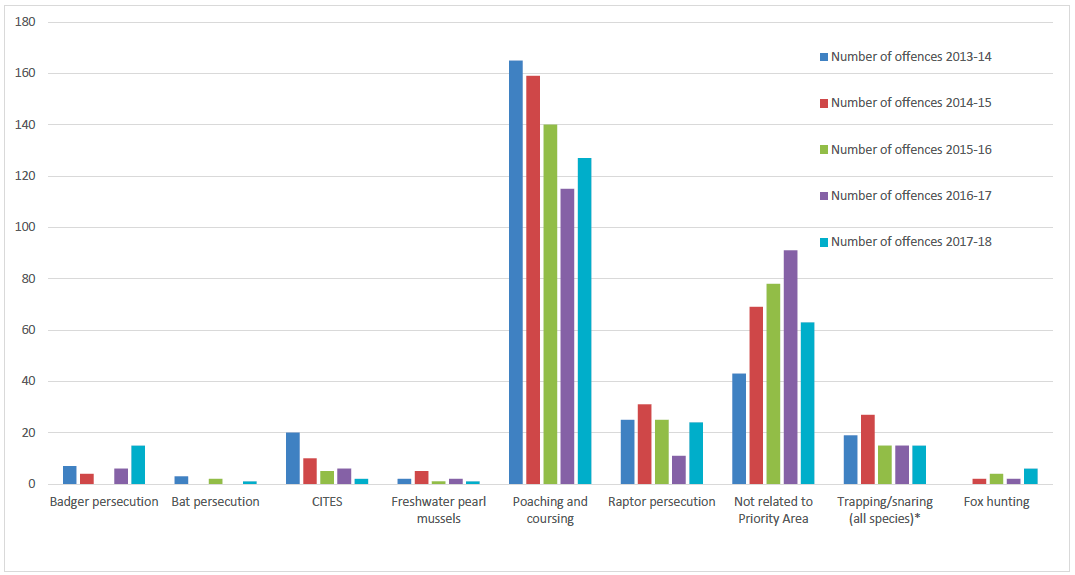
Source: Police Scotland
4.2 Badger persecution
All badgers in Scotland are protected by law, but they are sometimes still illegally targeted by those who see them as a pest or for the purposes of illegal animal fights.
Reckless or intentional damage, destruction and interference to badger setts (including sett blocking) is an offence which may arise from unlicensed forestry,
agricultural or construction works.
Recorded crimes
Table 17 and figure 2 show that there were 15 offences relating to badger persecution recorded by Police Scotland in 2016-17, compared to six in 2016-17. Eight of these offences were in relation to damage to a badger sett. Table 18 provides a quarterly breakdown of offences.
Table 17: Badger offences 2017-18 by Police Scotland Division
| Police Division | Type of offence | Number of offences |
|---|---|---|
| Argyll and West Dunbartonshire | Killing | 2 |
| Dumfries and Galloway | Digging, damage and obstruction to sett | 1 |
| Killing | 1 | |
| Fife | Digging, damage and obstruction to sett | 1 |
| Killing | 1 | |
| Forth Valley | Killing | 1 |
| Lanarkshire | Digging, damage and obstruction to sett | 1 |
| Lothians and Scottish Borders | Digging, damage and obstruction to sett | 2 |
| Killing | 2 | |
| North East | Digging, damage and obstruction to sett | 2 |
| Renfrewshire and Inverclyde | Digging, damage and obstruction to sett | 1 |
| Total | 15 |
Source: Police Scotland
Table 18: Badger offences 2017-18 by species and quarterly breakdown
| Type of Crime | Apr-Jun | Jul-Sep | Oct-Dec | Jan-Mar | Total |
|---|---|---|---|---|---|
| Digging, damage and obstruction to sett | 1 | 1 | 4 | 2 | 8 |
| Killing | 6 | - | 1 | - | 7 |
| Total | 7 | 1 | 5 | 2 | 15 |
Source: Police Scotland
Figure 2: Police Scotland disaggregated offence data for badger persecution 2013-14 to 2017-18
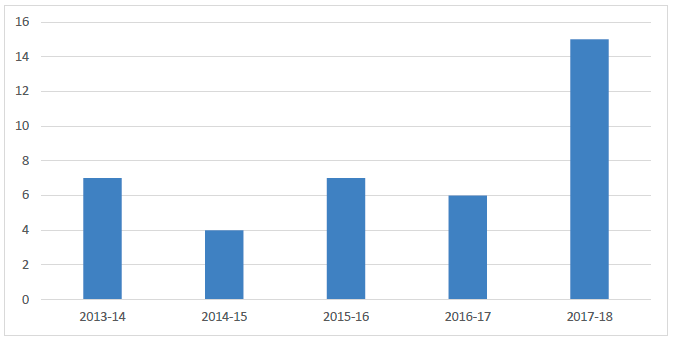
Source: Police Scotland
4.3 Bat persecution
Bats and their roosts are protected by the Conservation (Natural Habitats, &c.) Regulations 1994), which gives strict legal protection to all species listed under Annex IV of the EU Habitats Directive – known as European Protected Species (EPS). Scotland’s bat population is relatively small compared to other parts of the UK.
Bats, their breeding sites and resting places are at particular risk from development works and evidencing the presence of bats in these cases can be very challenging. Police Scotland work closely with SNH bat specialists in the investigation of any alleged offences.
Recorded crimes
Table 19 and figure 3 show that there was one offence involving bat persecution recorded by Police Scotland in 2017-18.
Table 19: Bat offences 2017-18 by Police Scotland Division
| Police Division | Type of offence | Number of offences |
|---|---|---|
| Highland and Islands | Destruction of roost | 1 |
| Total | 1 |
Source: Police Scotland
Figure 3: Police Scotland disaggregated offence data for bat persecution 2013-14 to 2017-18
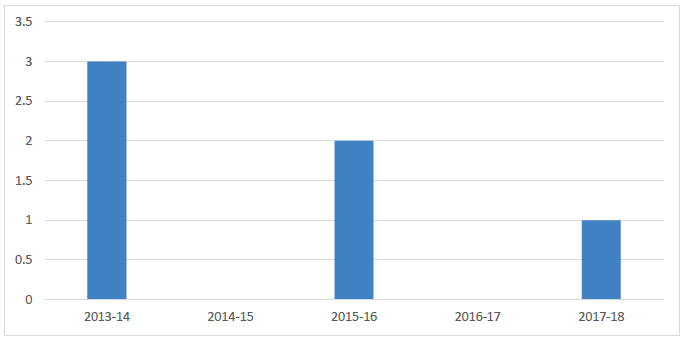
Source: Police Scotland
4.4 Convention on International Trade in Endangered Species of Wild Fauna and Flora (CITES)
CITES is the Convention on International Trade in Endangered Species of Wild Fauna and Flora. It is an international agreement between governments, which aims to protect certain animal and plant species from over-exploitation by trade.
In Scotland and the rest of the UK, this agreement is given legal authority by the Control of Trade in Endangered Species (Enforcement) Regulations 1997, known as COTES.
Recorded crimes
Table 19 and figure 4 show that two CITES-related offences were recorded by Police Scotland in 2017-18, compared to six in 2016-17.
Table 19: Summary of 2017-18 CITES offences
| Police Division | Type of Offence | Date |
|---|---|---|
| Edinburgh | Sale of endangered species | June 2017 |
| Highland and Islands | Jaw/teeth removed from dead whale | April 2017 |
Source: Police Scotland
Figure 4: Police Scotland disaggregated offence data for CITES 2013-14 to 2017-18
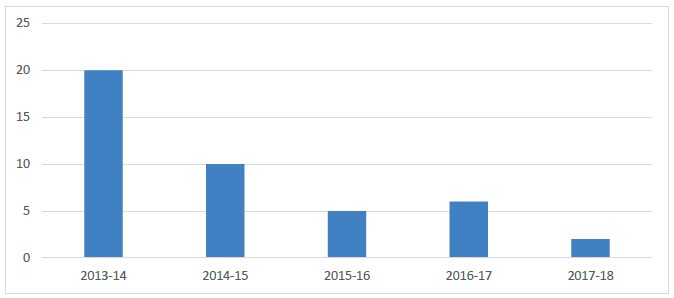
Source: Police Scotland
4.5 Freshwater Pearl Mussels
Scotland supports several of the largest remaining populations of freshwater pearl mussels (FWPM) in the world some of which continue to be damaged by criminal activity. Pearl fishing continues in Scotland, almost uniquely within Europe. FWPM are also threatened by unlawful river engineering and pollution.
Recorded crimes
Police Scotland recorded one offence in relation to FWPM during 2017-18 following the discovery of historic taking of FWPM. This compares to two offences in 2016-17.
Table 20: Summary of 2017-18 FWPM offences
| Police Division | Type of Offence | Date |
|---|---|---|
| Highland and Islands | Discovery of historical kills of FWPM at locus | Mar-18 |
Source: Police Scotland
Figure 5: Police Scotland Disaggregated Offence Data for freshwater pearl mussels for 2013-14 to 2017-18
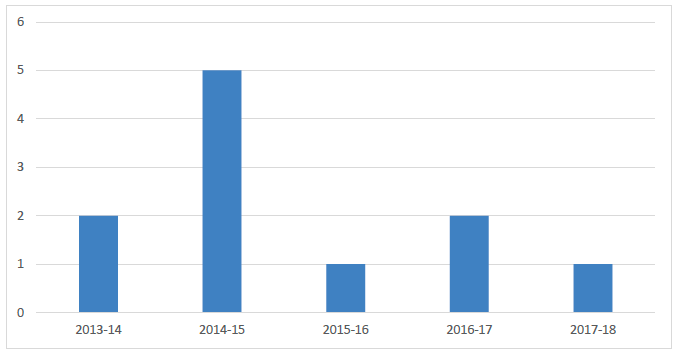
Source: Police Scotland
4.6 Poaching and coursing
Poaching involves the taking of deer, fish or other game without permission, or using unlawful methods. Coursing is the hunting of animals with dogs. This section sets out the new Police Scotland disaggregated data in addition to providing an overview on the work of the Poaching & Coursing Priority Delivery Group.
Recorded crimes
During 2017-18, 127 poaching and coursing offences were recorded by Police Scotland, compared to 115 offences in 2016-17. Table 21 shows the North East Division has the highest number of recorded hare coursing offences at 25, while Highland and Islands has the highest number of recorded fish poaching offences at 17.
Table 22 shows that hare coursing offences are the most commonly recorded at 60 offences, while fish poaching accounted for a further 44 offences. Most fish poaching offences were in relation to salmon, and all poaching offences show a seasonal bias towards the months from April to September.
Table 21: Poaching and coursing offences 2017-18 by Police Scotland Division
| Police Division | Target Species | Number of offences |
|---|---|---|
| Argyll and West Dunbartonshire | Deer | 1 |
| Fish | 3 | |
| Dumfries and Galloway | Deer | 3 |
| Unknown | 1 | |
| Edinburgh | Deer | 1 |
| Fife | Hare | 11 |
| Forth Valley | Fish | 4 |
| Hare | 3 | |
| Highland and Islands | Deer | 8 |
| Fish | 17 | |
| Lanarkshire | Deer | 4 |
| Fish | 10 | |
| North East | Fish | 5 |
| Hare | 25 | |
| Renfrewshire and Inverclyde | Fish | 2 |
| Tayside | Deer | 2 |
| Fish | 1 | |
| Hare | 11 | |
| The Lothians and Scottish Borders | Deer | 3 |
| Fish | 2 | |
| Hare | 10 | |
| Total | 127 |
Source: Police Scotland
Table 22: Poaching offences 2017-18 by species and quarterly breakdown
| Target Species | Apr-Jun | Jul-Sep | Oct-Dec | Jan-Mar | Total |
|---|---|---|---|---|---|
| Deer | 5 | 5 | 6 | 6 | 22 |
| Fish | 20 | 17 | 4 | 3 | 44 |
| Hare | 25 | 12 | 14 | 9 | 60 |
| Unknown | - | - | - | 1 | 1 |
| Total | 50 | 34 | 24 | 19 | 127 |
Source: Police Scotland
Figure 6: Police Scotland disaggregated offence data for poaching and coursing 2013-14 to 2017-18
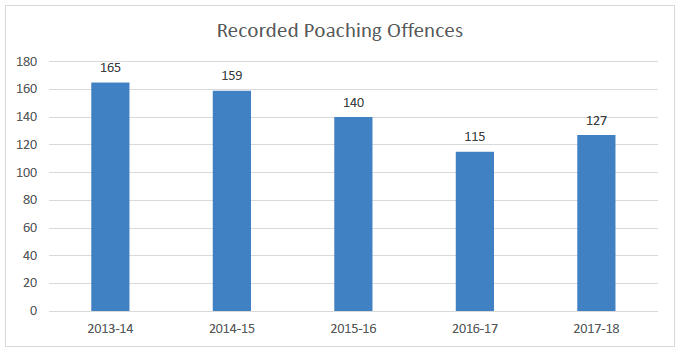
Source: Police Scotland
4.7 Raptor persecution
The persecution of raptors, or birds of prey, is the most high-profile type of wildlife crime in Scotland and it can have a serious impact on the populations of some raptor species at local, regional or (if carried out more widely) national level.
This section presents Police Scotland disaggregated data and SASA poisoning figures in relation to raptor offences.
Poisonings and other recorded crimes
Table 23 and figure 7 show the numbers of birds of prey confirmed by SASA as illegally poisoned between 2013-14 and 2017-18, alongside the number of incidents which resulted in these poisonings. The figures show that buzzards (21) remain the most commonly recorded victim of illegal poisoning over the five year period, followed by red kites (18) and Peregrine falcons (3).
Table 23: Bird of prey poisonings, Scotland, 2013-14 to 2017-18
| Year | Number of birds of prey poisoned (by species) | Number of Incidents* | ||||
|---|---|---|---|---|---|---|
| Buzzard | Red kite | Golden eagle | Peregrine falcon | All | ||
| 2013-14 | 7 | 12 | 1 | 1 | 21 | 6 |
| 2014-15 | 3 | 3 | - | 1 | 7 | 6 |
| 2015-16 | 5 | 1 | - | - | 6 | 5 |
| 2016-17 | 3 | 1 | - | - | 4 | 3 |
| 2017-18 | 3 | 1 | - | - | 4 | 4 |
| Total | 21 | 18 | 1 | 2 | 42 | 24 |
Source: Science and Advice for Scottish Agriculture (SASA)
*One incident may involve more than one bird
The number of poisoning incidents over the last five years has remained relatively low, however, illegal poisoning still has the capacity to kill high numbers of birds. For example, the large discrepancy in 2013-14 between the numbers of birds poisoned (21) and the number of incidents (6) was due to a single mass poisoning incident in Ross-shire, where 12 red kites and four buzzards were confirmed to have been killed with an illegal pesticide.
Figure 7: Bird of prey poisonings 2013-14 to 2017-18
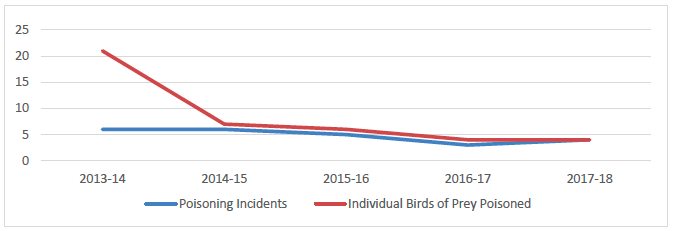
Source: SASA
Recorded crimes
Recorded raptor persecution offences more than doubled in 2017-18, with 24 offenses recorded compared to 11 in 2016-17.
Figure 8, table 24 and table 25 show a summary of bird of prey incidents recorded by Police Scotland from 2013-18 and offences recorded in 2013-18. A direct comparison between the datasets is not possible as incidents may involve multiple offences. However the tables do demonstrate general trends. As with the SASA poisoning data, these figures show that the buzzard (involved in 31 of the 98 cases) was the species most commonly affected over the five year period.
Shooting remains the highest recorded crime type for the period (31), followed by poisoning (23). It should be noted that one incident in this period in The Lothians and Scottish Borders involved the persecution of 10 raptors.
Financial year data for wider bird of prey crime has only been available from 2013-14 onwards. Subsequent reports will use this data to enable direct comparisons between datasets.
Figure 8: Recorded Bird of prey incidents 2013-14 to 2017-18
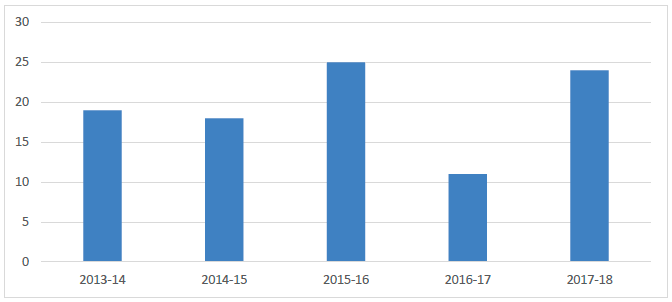
Source: Police Scotland
Table 24: Recorded bird of prey cases in Scotland, 2013-14 to 2017-18 by species involved
| Number of Cases (by species involved) | ||||||||||||||||
|---|---|---|---|---|---|---|---|---|---|---|---|---|---|---|---|---|
| Buzzard | Hen Harrier | Peregrine | Red Kite | Eagle | Sea Eagle | Golden Eagle | Goshawk | Merlin | Osprey | Red Kite & Buzzard | Barn Owl | Short Eared Owl | Tawny Owl | Unknown | Total | |
| 2013-14 | 8 | 2 | 2 | 2 | - | - | 1 | 1 | - | 1 | 1 | - | - | 1 | - | 19 |
| 2014-15 | 6 | 1 | 3 | 4 | - | - | 1 | 1 | - | - | - | - | - | 1 | 1 | 18 |
| 2015-16 | 12 | 2 | 1 | 4 | - | - | 1 | 1 | - | 2 | 1 | - | - | - | 1 | 25 |
| 2016-17 | 4 | - | 1 | - | - | - | 1 | 1 | - | 3 | 1 | - | - | - | - | 11 |
| 2017-18 | 1 | 2 | 1 | 1 | 1 | 1 | 1 | - | 1 | 1 | - | 1 | 1 | - | 12 | 24 |
| Total | 31 | 7 | 8 | 11 | 1 | 1 | 5 | 4 | 1 | 7 | 3 | 1 | 1 | 2 | 14 | 97 |
Source: Police Scotland
Figures from 2013-2014 and 2014-2015 relates to incident data, which may include multiple offences and victims. Figures from 2015-16 and 2016-17 relates to offence data, which relates to individual offences.
Table 25: Recorded bird of prey cases in Scotland, 2013-14 to 2017-18 by type of crime
| Number of Cases (by type of crime) | |||||||
|---|---|---|---|---|---|---|---|
| Disturbance | Egg theft | Other | Poisoning | Shooting | Trapping | Total | |
| 2013-14 | 2 | - | - | 6 | 8 | 3 | 19 |
| 2014-15 | 1 | - | 2 | 6 | 8 | 1 | 18 |
| 2015-16 | 3 | - | 3 | 6* | 8 | 6* | 25 |
| 2016-17 | 4 | 1 | - | 3 | 2 | 1 | 11 |
| 2017-18 | 3 | 1 | 11 | 2 | 5 | 2 | 24 |
| Total | 13 | 2 | 16 | 23* | 31 | 13* | 97 |
Source: Police Scotland
* one incident involved both trapping and poisoning
Figures from 2013-2014 and 2014-2015 relates to incident data, which may include multiple offences. Figures from 2015-16 and 2016-17 relates to offence data, which relates to individual offences.
Table 26 shows that The Lothians and Scottish Borders Division recorded the highest number of offences in relation to birds of prey with 13 offences of the 24 total.
Table 26: Summary of recorded bird of prey offences in Scotland 2017-18 by Police Scotland Division
| Police Division | Target Species | Number of offences |
|---|---|---|
| Argyll and West Dunbartonshire | Hen Harrier | 1 |
| Dumfries and Galloway | Red Kite | 1 |
| Fife | Sea Eagle | 1 |
| Highland and Islands | Golden Eagle | 1 |
| Osprey | 1 | |
| Raptor | 1 | |
| Lanarkshire | Hen Harrier | 1 |
| Peregrine | 1 | |
| Short eared owl | 1 | |
| North East | Eagle | 1 |
| Tayside | Buzzard | 1 |
| The Lothians and Scottish Borders | Merlin | 1 |
| Raptor | 10 | |
| Barn Owl | 1 | |
| unknown | 1 | |
| Total | 24 |
Source: Police Scotland
Table 27 and Figure 9 shows a majority of recorded bird of prey offences occurring during April to June, with 18 of the 24 total offences.
Table 27: Bird of prey offences 2017-18 by species and quarterly breakdown
| Target species | Apr-Jun | Jul-Sep | Oct-Dec | Jan-Mar | Total |
|---|---|---|---|---|---|
| Buzzard | - | - | 1 | - | 1 |
| Eagle | 1 | - | - | - | 1 |
| Golden Eagle | 1 | - | - | - | 1 |
| Hen Harrier | 1 | - | 1 | - | 2 |
| Merlin | 1 | - | - | - | 1 |
| Raptor | 10 | - | 1 | - | 11 |
| Peregrine | 1 | - | - | - | 1 |
| Osprey | 1 | - | - | - | 1 |
| Barn Owl | - | - | - | 1 | 1 |
| Red Kite | - | - | - | 1 | 1 |
| Sea Eagle | 1 | - | - | - | 1 |
| Short eared owl | 1 | - | - | - | 1 |
| unknown | - | - | 1 | - | 1 |
| Total | 18 | 0 | 4 | 2 | 24 |
Source: Police Scotland
Figure 9: Bird of prey offences quarterly breakdown 2013-14 to 2017-18
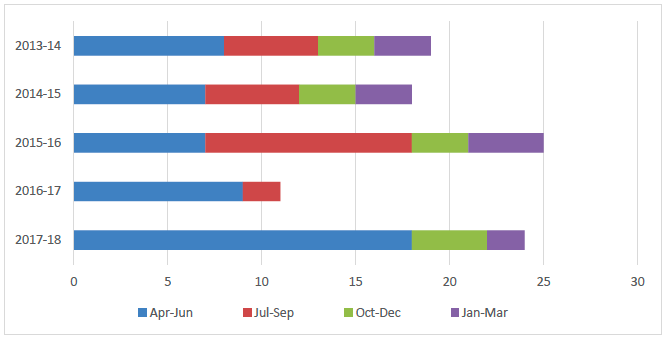
Source: Police Scotland
Table 28 provides a detailed breakdown of bird of prey incidents for the financial year 2017-18. One incident may involve more than one bird, for example, the raptor incidents recorded in The Lothians and Scottish Borders in June 2017.
Table 28: Details of recorded bird of prey incidents in Scotland 2017-18
| Species Targeted | Police Division | Type of offence | Month and year |
|---|---|---|---|
| Buzzard | Tayside | Poisoning | October 17 |
| North East | Disturbance | April 17 | |
| Highlands and Islands | Egg Stealing | May 17 | |
| Hen Harrier | Argyll and West Dunbartonshire | Shooting | October 17 |
| Lanarkshire | Shooting | May 17 | |
| Merlin | The Lothians and Scottish Borders | Shooting | June 17 |
| Osprey | Highlands and Islands | Disturbance | June 17 |
| Peregrine | Lanarkshire | Disturbance | April 17 |
| Raptor | Highlands and Islands | Trapping | June 17 |
| The Lothians and Scottish Borders | Other | December 17 | |
| The Lothians and Scottish Borders* | Other* | June 17* | |
| The Lothians and Scottish Borders | Shooting | June 17 | |
| Barn Owl | The Lothians and Scottish Borders | Trapping | January 18 |
| Red Kite | Dumfries and Galloway | Poisoning | March 18 |
| Sea Eagle | Fife | Disturbance | May 17 |
| Short Eared Owl | Lanarkshire | Shooting | June 17 |
| Unknown | The Lothians and Scottish Borders | Other | December 17 |
source: Police Scotland
*This incident involved eight raptors and multiple types of offence
4.8 Fox Hunting and the Protection of Wild Mammals (Scotland) Act 2002
This section highlights offences under the Protection of Wild Mammals (Scotland) Act 2002. Section 1 of the 2002 Act prohibits the deliberate hunting of a wild mammal with a dog (subject to certain exceptions). The Act is most commonly used in connection with hare coursing, although it has also been used for incidents relating to foxes, deer and badgers. It does not prohibit the hunting of rabbits or rats by dogs.
Recorded crime
Table 29 and figure 10 shows that from the now disaggregated data from Police Scotland, Six of the 41 hunting with dogs cases related to fox hunting offences, rather than activities such as hare coursing. The total number of “hunting with dogs offences” recorded in 2017-18 (41) has almost doubled compared to 2016-17 (22). Hare coursing makes up the majority of these offences (32).
Figure 10: Police Scotland offence data for fox hunting 2013-14 to 2017-18
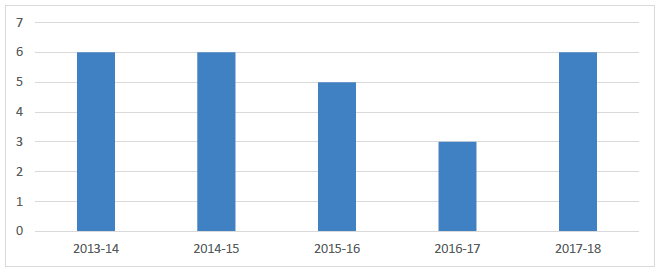
Source: Police Scotland
Table 29*: Protection of Wild Mammals (Scotland) Act 2002 ‘hunting with dogs’ offences 2017-18 by Police Scotland Division
| Police Division | Target species | Number of offences |
|---|---|---|
| Dumfries and Galloway | Unknown | 1 |
| Fife | Fox | 3 |
| Hare | 6 | |
| Lanarkshire | Roe deer | 1 |
| North East | Hare | 12 |
| Tayside | Deer | 1 |
| Hare | 6 | |
| The Lothians and Scottish Borders | Fox | 3 |
| Hare | 8 | |
| Total | 41 | |
Source: Police Scotland
*The table does not show offences under Section 18(1) of the Wildlife and Countryside Act for attempts to commit an offence in relation to killing or taking a wild mammal.
Table 30: Protection of Wild Mammals (Scotland) Act 2002 ‘hunting with dogs’ offences 2017-18 by species and quarterly breakdown
| Target Species | Apr-Jun | Jul-Sep | Oct-Dec | Jan-Mar | Total |
|---|---|---|---|---|---|
| Deer | 1 | 1 | 2 | ||
| Fox | 2 | 1 | 3 | 6 | |
| Hare | 3 | 13 | 8 | 8 | 32 |
| Roe Deer | 1 | 1 | |||
| Unknown | 1 | 1 | |||
| Grand Total | 7 | 13 | 9 | 12 | 41 |
Source: Police Scotland
Prosecutions
For the period 2010-2018, fewer than 5 cases relating to fox hunting were reported to COPFS.
4.9 Trapping and Snaring
Trapping and snaring are methods which can be legitimately used for the control of some types of wildlife such as corvids, rodents or foxes. This may be for conservation purposes, to protect agricultural or sporting interests or for human health and safety reasons. However, the use of traps and snares is subject to legal restrictions designed to prevent harm to non-target species or unnecessary cruelty.
Recorded crimes
Trapping and snaring figures are not shown as part of the recorded crime statistics in Table 1 as the offence data cannot be broken down to that level.
The Police Scotland disaggregated offence data in Table 15 shows that 15 offences were recorded for 2017-18. This remains unchanged from the previous two years with 15 offences recorded each for 2015-16 and 2016-17 but is also a decrease from the 27 offences recorded for 2014-15.
The Scottish SPCA identified four incidents relating to trapping or snaring offences which were investigated solely by its SIU inspectors.
In 2017-18, fewer than 5 cases related to trapping and snaring were reported to COPFS.
Table 31 shows that there is no spatial bias to recorded trapping and snaring offences in 2017-18.
Table 31: Trapping and snaring offences 2017-18 by Police Scotland Division
| Police Division | Type of offence | Target Species | Number of offences |
|---|---|---|---|
| Argyll and West Dunbartonshire | Snare | Badger | 2 |
| Snare | Unknown | 2 | |
| Dumfries and Galloway | Snare | Badger | 1 |
| Fife | Snare | Unknown | 2 |
| Highlands and Islands | Larson Trap | Unknown | 1 |
| Otter Trap | Otter | 1 | |
| Snare | Unknown | 1 | |
| North East | Gin trap | cat | 1 |
| Renfrew and Inverclyde | Snare | Roe Deer | 1 |
| Snare | Unknown | 1 | |
| The Lothian and Borders | Snare | Unknown | 1 |
| Multiple offences | Unknown | 1 | |
| Total | 15 | ||
Source: Police Scotland
Table 32 shows a slight bias towards offences occurring from April to September. This may be associated with an increase in trapping and snaring activity during these months and/or an increase in detection due to increased recreational use of the countryside during this time.
Table 32: Trapping and snaring offences 2017-18 by quarterly breakdown
| Type of Crime | Apr-Jun | Jul-Sep | Oct-Dec | Jan-Mar | Total |
|---|---|---|---|---|---|
| Gin trap | - | 1 | - |
- | 1 |
| Larson Trap | - | 1 | - | - | 1 |
| Multiple offences | - | - | - | 1 | 1 |
| Otter Trap | - | - |
1 | - | 1 |
| Snare | 4 | 6 | 1 | - | 11 |
| Total | 4 | 8 | 2 | 1 | 15 |
Source: Police Scotland
Contact
Email: leia.fitzgerald@gov.scot
There is a problem
Thanks for your feedback